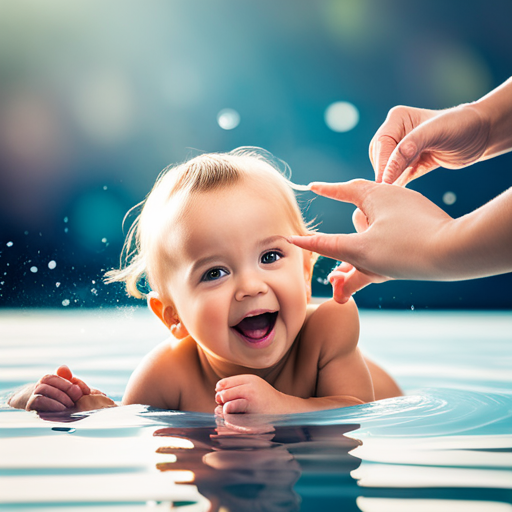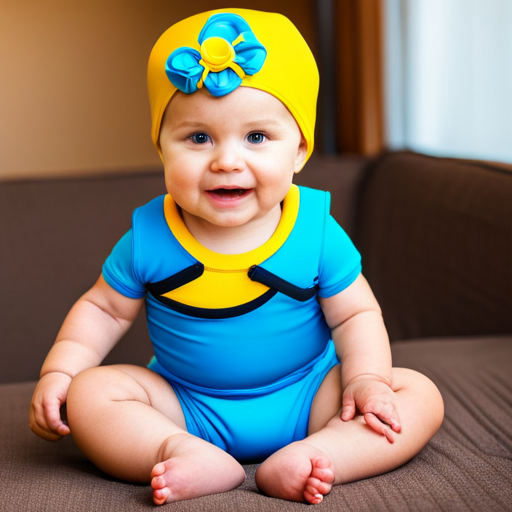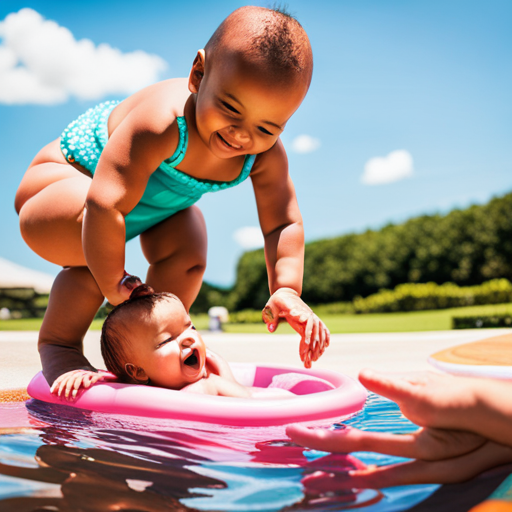"Cherishing Little Steps - A Haven for Baby and Family Journeys"
Baby’s First Swim
Are you ready to make unforgettable memories with your little one? Dive into the world of baby’s first swim and discover the joy of introducing your precious bundle of joy to the water.
From the moment you step foot in the pool, you’ll feel a special connection as you guide your baby through this exciting new experience. This intimate journey is not just about splashing and having fun, but also about fostering early water confidence and promoting physical development.
With age-appropriate recommendations and expert safety tips, you can ensure that your baby is comfortable and secure throughout their aquatic adventure.
So, grab your swim gear and get ready to embark on this incredible bonding experience with your little water baby. Let the splashing begin!
Key Takeaways
- Baby swimming promotes developmental milestones and improves motor skills, coordination, and strength.
- Early swimming experiences contribute to water safety skills and reduce the risk of drowning.
- Baby swim classes help familiarize your baby with water, teach basic water skills, and incorporate important safety techniques.
- Constant supervision and proper swim gear are essential for a safe and enjoyable baby swimming experience.
Importance of Baby Swimming

If you want your baby to develop confidence in the water and build essential swimming skills from an early age, then it’s time to dive into the importance of baby swimming.
Water safety is a crucial aspect of baby swimming. By introducing your baby to the water at a young age, you can help them become familiar with the water environment and reduce the risk of accidents. Learning to swim early on can also lay a strong foundation for future water safety practices.
Baby swimming also plays a significant role in achieving developmental milestones. When babies are in the water, they have the opportunity to engage in various physical activities that promote their motor skills, coordination, and strength. The resistance of the water helps to develop their muscles and improve their balance. Moreover, swimming can enhance their cognitive abilities as they learn to navigate through the water and respond to different stimuli.
In addition, baby swimming provides an excellent opportunity for bonding and socializing. Parents can participate in the swimming sessions, creating a safe and intimate environment for their baby. This shared experience fosters a strong emotional connection between the parent and the baby.
Age Recommendations for Baby Swimming

To determine the optimal age for your baby to start swimming, consider their individual readiness and consult with a pediatrician or swimming instructor. While there’s no set age for babies to begin swimming lessons, experts generally recommend starting around 6 months old. At this age, babies have developed better head control and stronger neck muscles, making it easier for them to support themselves in the water.
Water temperature is an important factor to consider when introducing your baby to swimming. The water should be comfortably warm, around 86°F (30°C), to ensure your baby’s comfort and safety. It’s essential to choose a swimming facility that maintains the appropriate water temperature for infants.
When it comes to choosing a swim instructor for your baby, look for someone who specializes in teaching infants and young children. A qualified instructor will have the knowledge and experience to create a safe and enjoyable environment for your baby’s first swimming experience. They’ll also be able to guide you on the best techniques to use when introducing your baby to the water.
Benefits of Baby Swimming

Discover the numerous physical and cognitive benefits your baby can gain from early swimming experiences. Swimming isn’t only a fun activity for babies, but it also offers a range of developmental advantages. Here are four key benefits of baby swimming:
-
Physical Development: The water provides a low-impact environment that allows babies to strengthen their muscles and improve coordination. Floating and moving in water can enhance their balance and motor skills.
-
Cognitive Development: Splashing, kicking, and reaching for objects in the water stimulate your baby’s brain development. The sensory experiences of swimming help with their cognitive skills, including problem-solving, spatial awareness, and hand-eye coordination.
-
Water Safety: Introducing your baby to swimming at an early age can contribute to their water safety skills. Familiarity with water and basic swimming techniques can help reduce the risk of drowning and increase their confidence in and around water.
-
Bonding Activities: Swimming with your baby provides a wonderful opportunity for bonding and creating special memories. The close physical contact and shared experiences in the water strengthen the parent-child relationship and promote a sense of trust and security.
Preparing for Baby’s First Swim

Before you take your baby for their first swim, there are a few important things to consider and prepare for. Baby swim safety should be your top priority. Make sure the swimming pool or the area where you plan to take your baby for a swim is safe and secure. Look for a pool that has shallow and warm water, as babies are more comfortable in these conditions. Additionally, check that the pool has proper fencing and safety measures in place.
To ensure a safe and enjoyable experience, it’s also recommended to enroll your baby in baby swim classes. These classes are designed to introduce babies to the water in a controlled and supervised environment. They provide an opportunity for your baby to become familiar with the water and learn basic water skills, such as floating and kicking. Moreover, these classes often incorporate important safety techniques, including how to respond to emergencies in the water.
When selecting a baby swim class, look for certified instructors who specialize in teaching infants. They should have the necessary expertise to handle and guide your baby in the water. Additionally, ensure that the class follows safety guidelines and maintains a clean and hygienic environment.
Choosing the Right Swim Gear for Your Baby

Now, let’s move on to picking the perfect swim gear for your baby. When it comes to baby swim lessons, having the right gear is essential for a safe and enjoyable experience. Here are four items to consider:
-
Swim Diapers: Swim diapers are a must-have for your little one. They’re designed to prevent any accidents in the water while still allowing your baby to enjoy the fun. Look for swim diapers that are snug-fitting and have strong elastic around the waist and legs.
-
Swimwear: Opt for swimwear that provides sun protection and is comfortable for your baby to move around in. Look for swimsuits or rash guards with UPF (Ultraviolet Protection Factor) to shield your baby’s delicate skin from harmful UV rays.
-
Swim Cap: A swim cap can help keep your baby’s hair out of their face and protect it from chlorine or saltwater. Choose a soft and stretchy swim cap that’s easy to put on and take off.
-
Swim Toys: Make swimming even more enjoyable for your baby with some fun swim toys. From floating toys to water squirters, these toys can help your baby feel more at ease in the water and make the experience more engaging.
Safety Tips for Baby Swimming
When it comes to ensuring a safe swimming experience for your baby, it is important to follow these essential safety tips. Babies are naturally drawn to water, but they lack the skills and understanding to stay safe. By taking the necessary precautions, you can help protect your little one and make their swimming experience enjoyable.
One of the most important aspects of water safety for babies is constant supervision. Never leave your baby unattended in or around water, even for a moment. Accidents can happen quickly, so it’s crucial to always keep a close eye on your little swimmer.
Another key safety tip is to enroll your baby in swim lessons. These lessons are designed specifically for infants and can teach them basic water skills and safety techniques. Look for certified instructors who have experience working with young children.
In addition to constant supervision and swim lessons, here are a few more safety tips to keep in mind:
| Safety Tip | Description |
|---|---|
| Use flotation devices | Invest in a properly fitting life jacket or floatation device for your baby. |
| Secure the pool area | Install a fence or barrier around your pool to prevent accidental access. |
| Teach water boundaries | Teach your baby to stay within designated water boundaries to avoid potential dangers. |
Introducing Your Baby to the Water

To ensure a positive and comfortable experience for your baby, it’s important to gradually introduce them to the water using gentle and supportive techniques. Here are four steps to help you introduce your baby to the water while building their water confidence:
-
Start in a familiar environment: Begin by introducing your baby to water in a controlled and familiar setting, such as their bathtub. This helps them feel safe and secure, allowing them to gradually get used to the sensation of being in water.
-
Use a baby pool: Once your baby is comfortable in the bathtub, you can move on to using a small baby pool. Fill it with just a few inches of water and let your baby splash and play. Always stay close and provide constant supervision to ensure their safety.
-
Gentle water play: As your baby becomes more comfortable, you can introduce gentle water play activities, such as pouring water from a cup or using bath toys. This helps them associate water with fun and enjoyment.
-
Gradual introduction to swimming: When your baby is ready, you can gradually introduce them to swimming pools. Start in shallow water and hold them securely as you move through the water. Encourage kicking and floating to build their confidence and strength.
Fun Activities for Baby’s First Swim

Take the opportunity to engage your baby in enjoyable water activities during their first swim. These activities not only provide a fun experience for your little one but also help in their development and confidence in the water. Baby swim classes are a great way to introduce your baby to the water and learn essential water safety skills.
During their first swim, you can start with simple activities like gently splashing water on their hands and feet. This will help them get used to the sensation of water and build their comfort level. You can also try floating your baby on their back, supporting their head and neck, to help them feel relaxed and at ease in the water.
As your baby grows more comfortable, you can introduce games like ‘Row, Row, Row Your Boat’ where you gently rock them back and forth in the water. This helps in developing their balance and coordination. Singing songs and playing with floating toys can also make the experience more enjoyable for your baby.
It is important to always prioritize water safety during these activities. Keep a close eye on your baby at all times and ensure they’re within arm’s reach. Use age-appropriate flotation devices, such as swim vests or arm floats, to provide additional support and safety.
Capturing and Cherishing the Moments

Make sure to grab your camera and capture all the precious moments of your baby’s first swim. It’s a special occasion that you’ll want to remember and cherish for years to come. Taking photos and videos not only allows you to capture memories but also helps you create lasting bonds with your little one.
Here are four ways to make the most out of capturing and cherishing these moments:
-
Be prepared: Before the swim, make sure your camera or phone is fully charged and has enough storage space. Keep it within reach so you can quickly capture those spontaneous and adorable moments.
-
Focus on the details: Zoom in on your baby’s tiny fingers paddling through the water or their wide-eyed expression as they feel the sensation of being in the pool for the first time. These close-up shots will help you remember the little things that often get forgotten over time.
-
Embrace candid shots: Don’t be afraid to capture candid moments. Those genuine smiles, laughter, and even the occasional tears are all part of the experience. These authentic shots will bring back the emotions you felt during your baby’s first swim.
-
Document the journey: In addition to capturing the actual swim, consider documenting the journey leading up to it. Take pictures of your baby getting ready, the excitement in their eyes, and the anticipation building up. These photos will help tell the whole story and make the memories even more meaningful.
Frequently Asked Questions
Can Babies Start Swimming Before They Are 6 Months Old?
Yes, babies can start swimming before they’re 6 months old. Starting swimming lessons early has many benefits, like building water confidence and developing motor skills. It’s a great way to introduce them to the water in a safe and fun way.
What Should I Do if My Baby Cries During Their First Swim?
If your baby cries during their first swim, remember to stay calm and provide comfort. Try using gentle soothing techniques like singing or rocking. It’s important to adjust your expectations and remember that every baby is different.
Are There Any Specific Exercises or Techniques to Help My Baby Feel More Comfortable in the Water?
To help your baby feel more comfortable in the water, try incorporating exercises and techniques like gentle splashing, floating with support, and singing songs. These activities can make the swimming experience enjoyable and build their confidence.
How Long Should a Baby’s First Swimming Session Last?
For baby’s first swim, the duration should be kept short, around 10-15 minutes. This allows time to get them comfortable in the water without overwhelming them. Remember to always prioritize safety and fun!
Is It Safe for Babies to Wear Swim Diapers in the Pool?
Yes, it’s safe for babies to wear swim diapers in the pool. They provide extra protection against leaks, but it’s important to change them frequently. Remember, safety tips like constant supervision and avoiding crowded pools are also crucial.
Conclusion
Congratulations on taking the first step in introducing your baby to the wonderful world of swimming!
Did you know that starting swimming lessons early can actually reduce the risk of drowning by 88% for children aged 1 to 4?
By providing a safe and enjoyable environment for your little one to explore the water, you aren’t only helping them develop essential life skills but also ensuring their safety in and around water as they grow.
So dive in and create beautiful memories with your baby’s first swim!


